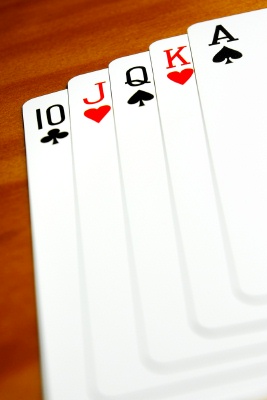|
|

Broadway - An ace high straight, AKQJT.
An ace high straight is nicknamed “Broadway,” and is also sometimes referred to as “Main Street.” This term can be used to describe an
ace high straight made in any game, but it is most commonly used in the discussion and analysis of Omaha games.
In an Omaha game, players are typically dealt a four card starting hand. Omaha is a
flop game, which means community cards are used.
These community cards consist of a three card
flop, followed by a turn card and a river card. Players are required to form their best five card hand by using exactly two cards from
their four card starting hand and exactly three cards from the community cards on the board. The game can be played either as a high-lo
game or as a high only game, and may be either Limit or Pot-Limit (or occasionally No-Limit).
Given that in an Omaha game, each player has nine cards from which to form his hand, both made hands and draws tend to run very big.
It is not uncommon for more than one player to make a full house on the same hand, and four of a kind is much more common than it is
in a Hold’em or Stud Game. Despite this fact, much of Omaha strategy and game theory revolves around the straight draw. This is
especially true for Pot-Limit play and the high only version of the game. There are several reasons for this.
In a Hold’em game, the object is of the game is to make a hand that is likely to be stronger than those of your opponents. It is nice
to make the nuts, but most of the time it is not
necessary to win the pot. Sometimes you will make the nuts and end up losing to a player who
outdraws you, but this is the exception rather than
the rule. Omaha is different. If you make a habit of drawing to non-nut hands, you will get crushed. In fact, many nut draws that you
would be happy to take in a Hold’em game should be thrown away in Omaha. One reason for this is because in an Omaha game, you are in
danger of being freerolled against.
In an Omaha game, it is not uncommon for multiple players to hold or draw at the same nut straight. If you hold the nut straight but
do not have any outs to make a bigger hand, like a flush,
a full house, or a higher straight, your opponent who also holds the nut straight may be
freerolling against you. This means that even if
you hold the nuts, you may be in grave danger. If you are playing Pot-Limit, getting freerolled can cost you your entire
stack. Your concern about getting freerolled shouldn’t
start when you make the nuts. It’s also a consideration for your hand selection and your draw selection.
When you play Hold'em, your straight draws usually have either four or eight outs. In Omaha, four and eight out straight draws are
considered weak. Having a four card hand allows you to “wrap” around straight draws, by covering a run of cards. If a card that falls
within your wrap hits the board, you will have made a straight. In Omaha, a wrap on an ace high straight draw is called a “Broadway
Wrap.” If you held A ♠ K ♠ T♣ 9♣, and the flop was Q♣ J♠ 6♦, you would have flopped a Broadway
wrap with two back door flush draws. You can see how well this hand would fare against an eight out straight draw, for example
T♠ 9♦ 7♣ 7♥. It is the possibility for huge wraps, which can have a better probability of hitting than missing,
that make straight draws so powerful in Omaha. Imagine that you held Q♥ J♥ 8♠ 7♣, and the flop came
T♣ 9♦ 5♠. You would have flopped a twenty card wrap with two cards to come. In this situation, you make a straight with
any K– Q–J –8 -7-6. This is a huge draw.
Straight draws play such a prominent role in Omaha games, not only because of the sheer power they possess, but also because they
often can be a favorite in situations where large pots are built. This is especially true for Pot-Limit play, where drawing hands have
enormous value. The classic example of a straight draw being a favorite in a big pot situation would be when you have a full wrap
against a dry top set on the flop.
Another reason straight draws can win big pots is because they are almost always present, and can be difficult to read and defend
against. In Pot-Limit play, when a flush draw appears on the flop, or the board pairs, it can kill the action. The nut flush draw is a
very powerful draw to flop, and players are wary about putting money in the pot when there is a distinct possibility it is out there.
Players are also wary of the nut full house when the board pairs. But the straight wrap is almost always present. You only need to
have two cards within two ranks of each other on the board to produce the possibility for a strong wrap. For example imagine that the
board contains an 8 and a 6. If a player held T-9-5-7, they would have an extremely strong straight draw. Even a four card gap on the
board can produce a nine card wrap. So long as the board does not pair and the flush draw is not made, the straight draw is powerful
and ever present.
Usage: I Made Broadway, 13 Card Broadway Wrap, 16 Card Broadway Wrap
Previous Poker Term: Bring-In
Next Poker Term: Brush |
|









